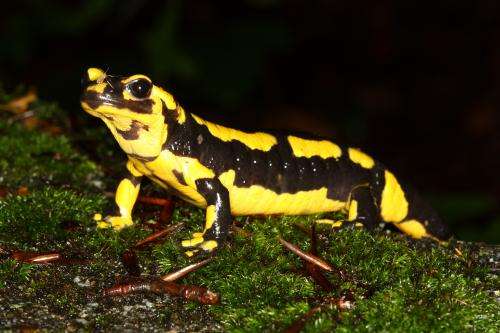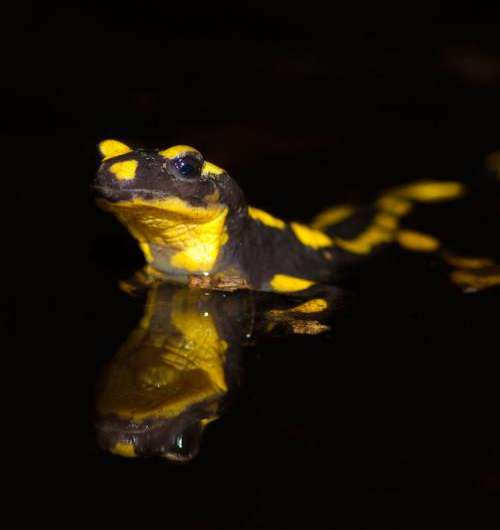Salamanders under threat from deadly skin-eating fungus

A new species of fungus that eats amphibians' skin has ravaged the fire salamander population in the Netherlands, bringing it close to regional extinction.
Fire salamanders, recognisable by their distinctive yellow and black skin patterns, have been found dead in the country's forests since 2010. The population has fallen to around 10 individuals, less than four per cent of its original level, but what has been killing them has been a mystery until now.
Scientists from Ghent University, Imperial College London, Vrije Universiteit Brussel and the Dutch conservation group Ravon have isolated a new species of fungus from the dead animals and found that it can rapidly kill fire salamanders. They have named the fungus Batrachochytrium salamandrivorans, the second part meaning "salamander-eating", and report their findings today in the Proceedings of the National Academy of Sciences.
Fungi are increasingly recognised as important threats to biodiversity. A species related to the new fungus, Batrachochytrium dendrobatidis (Bd), has plagued amphibian populations across the globe and is thought to have wiped out more than 200 species worldwide. It causes the disease chytridiomycosis, which the International Union for the Conservation of Nature has called the single most devastating infectious disease in vertebrate animals.
The study's lead author, Professor An Martel from the University of Ghent, said: "In several regions, including northern Europe, amphibians appeared to be able to co-exist with Bd. It is therefore extremely worrying that a new fungus has emerged that causes mass mortalities in regions where amphibian populations were previously healthy."

Co-author Professor Matthew Fisher, from Imperial College London, said: "It is a complete mystery why we are seeing this outbreak now, and one explanation is that the new salamander-killing fungus has invaded the Netherlands from elsewhere in the world. We need to know if this is the case, why it is so virulent, and what its impact on amphibian communities will be on a local and global scale. Our experience with Bd has shown that fungal diseases can spread between amphibian populations across the world very quickly. We need to act urgently to determine what populations are in danger and how best to protect them."
The fungus can be passed between salamanders by direct contact, and possibly by indirect contact although this hasn't been proven. It invades the animal's skin, eventually destroying it completely. In tests, the fungus was not able to infect midwife toads, which have been threatened by chytridiomycosis, but whether other species might be vulnerable is unknown.
The scientists have brought surviving salamanders into captivity to protect the remaining population in the Netherlands. To aid further studies, they have also developed a diagnostic tool that enables the new fungus to be quickly identified. They tested 100 salamanders from Belgium, where the population has remained healthy, but so far there is no sign that the fungus has spread beyond the Netherlands.
More information: A Martel et al. 'Batrachochytrium salamandrivorans sp. nov. causes lethal chytridiomycosis in amphibians.' PNAS 2013. www.pnas.org/cgi/doi/10.1073/pnas.1307356110
Journal information: Proceedings of the National Academy of Sciences
Provided by Imperial College London




















